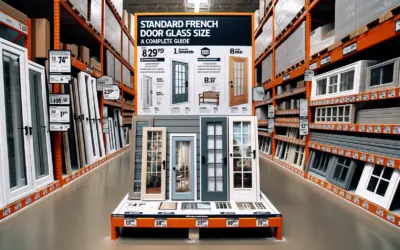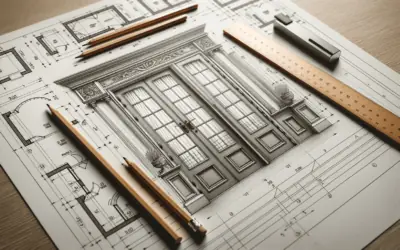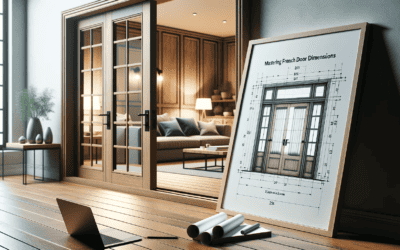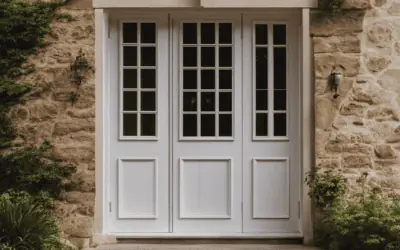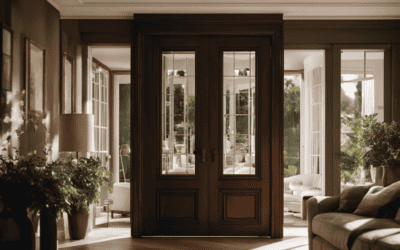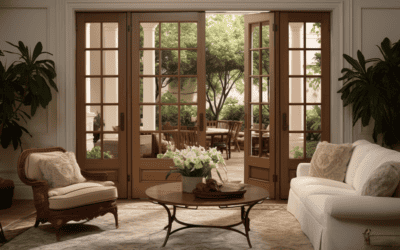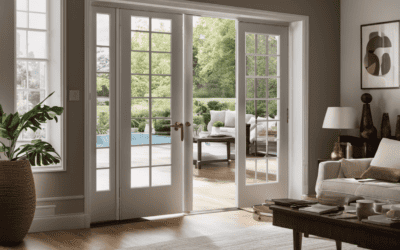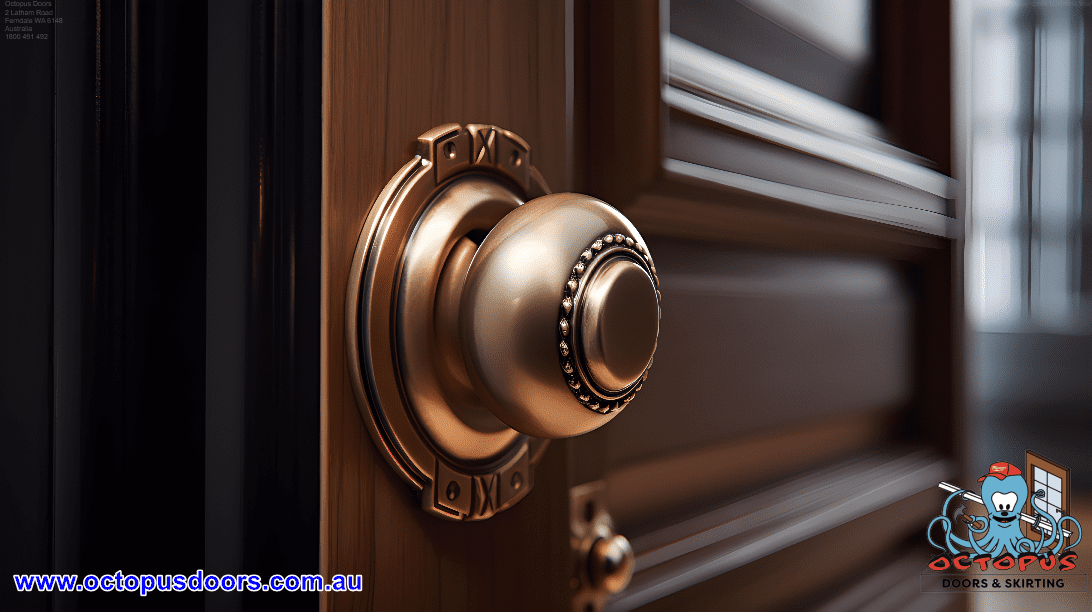
French door handles can indeed be replaced, offering a cost-effective and aesthetically pleasing solution to improve your home’s appearance. There are several reasons to replace your external French door handles, such as wear and tear, exposure to the elements, or a simple upgrade for a modern, high-quality look. By opting for a new handle rather than replacing the entire door, you can save money while still transforming the look of your home.
Step-by-Step Guide to Replacing French Door Handles
- Determine the correct replacement part: Before purchasing a new handle, ensure you have the correct replacement part number. This will help avoid any compatibility issues with your doors. Also, consider the style and finish of the new handle to match the existing hardware and maintain visual appeal.
- Remove the door trim: Carefully remove the four pieces of trim around the handles: one above and one below each of the two handles. This will reveal the hidden mounting screws for a polished, seamless appearance.
- Unfasten and remove the old handle: Unscrew the mounting screws and remove the old, broken door handle. If your door is a UPVC design, you will need to find the main door handle version as well as the slave door version if applicable.
- Install the new handle: Align the replacement handle with the mounting holes and secure it using the supplied screws.
- Replace the door trim: Finally, reattach the door trim to conceal the mounting screws and complete the process.
By following these straightforward steps, you can easily replace French door handles and achieve an updated, sophisticated look for your home’s exterior. Remember, researching the correct replacement handle and ensuring its compatibility with your existing door will guarantee a seamless and successful installation.
What kind of handles do you use on French doors?
The perfect handle set for your French doors will depend on their function, whether interior or exterior. These elegant doors, often featuring top-to-bottom glass, can effortlessly elevate the charm and character of any space. However, choosing the right handle requires careful consideration of the door’s attributes and utility. In this guide, we will explore the different types of handle sets suitable for French doors, so you can make an informed decision.
Step 1: Determine the Function of Your French Doors
Before diving into handle selection, it’s crucial to identify the purpose of your French doors. Some might serve as entrances or exits, while others are purely decorative, adding style and sophistication to your home.
- Interior French Doors: Typically used to separate living spaces, such as dining rooms and living rooms.
- Exterior French Doors: Function as entryways to patios or gardens, allowing natural light to flood your living space while providing access to outdoor areas.
Step 2: Selecting a Handle Set for Double Doors without Pre-Drilled Bore Holes
If your French doors do not have pre-drilled boreholes, then non-turning or dummy function door handles are ideal. These stylish and functional handles act as decorative pieces and do not move. A perfect blend of aesthetics and functionality!
Step 3: Keep Your Home Safe with Sturdy Locks for Exterior French Doors
For exterior French doors, prioritize safety with a strong handle set featuring a reliable locking mechanism. To allow access from both sides, you will need a total of four handles – two sets of two handles, including a non-moving, decorative one, often called a “dummy handle.”
Step 4: Latch and Lock Options for Interior French Doors
For interior French doors that need to latch, install a double dummy set on one side and a passage set on the other. If locking capabilities are required, opt for a privacy set in place of the passage set. Keep in mind that doors with latches will need boreholes.
In case your French doors utilize roller catches, flush bolts, or surface bolts for latching, use a double dummy set on each door.
How does door handles work on French doors?
The key to opening French doors lies in turning the active handle to release the latch while standing on the side with visible hinges. Compared to regular single doors, French doors feature two distinct handles. When turned, the active handle moves the latch, while its counterpart serves as a dummy handle, often for decorative purposes. In fact, many French door designs do not necessitate functional handles on both sides.
When selecting door locks for French doors, it’s crucial to consider the appropriate function for interior and exterior double doors. By incorporating highly relevant keywords and industry co-occurrences, such as *door locks*, *interior double doors*, and *exterior double doors*, this content streamlines the process of finding actionable tips and advice for everything related to French doors.
So, what should you remember when dealing with French doors? Always stand on the side where the hinges are visible, and turn the active handle to open the door effortlessly. By understanding these key aspects, you’re well on your way to mastering the art of French door opening.
Should French doors have two handles?
French doors accessible from both sides should have handles on each side, which means you’ll need four handles in total – two sets of two. However, not every French door configuration necessitates handles on both sides. Let’s explore some important aspects and steps to ensure your French door hardware installation is seamless and secure.
Dummy Handles: An Intriguing Decorative Feature
- One of the French door handles is often purely decorative and doesn’t move, known as a dummy handle. Stationary French doors typically have this type of handle.
Interior French Doors: Latching and Locking Solutions
- Double dummy sets are installed on one side and passage sets on the other for latching needs.
- If the doors need to lock, a privacy set replaces the passage set for added security.
Exterior French Doors: Boosting Home Security
- A robust lock is crucial for keeping your home safe from intruders.
- Combining a dummy entrance set and a regular entry set provides a locking mechanism between the two doors.
- Always ensure you order the correct handing for exterior French doors, as they come with heavy-duty astragal trim attached to the secondary door for increased protection.
To sum it up, accessible French doors from both sides require handles on each side. Interior French doors may use double dummy sets, passage sets, or privacy sets depending on latching and locking needs, while exterior French doors should have a dummy entrance set and a regular entry set for maximum security.
Do French doors have handles on both doors?
French doors can have handles on both sides, but this is dependent on the door configuration, with some requiring handles for latching or locking purposes. French doors often feature a dummy handle that is purely decorative and non-functional. As you update your space with these elegant doors, consider the specific needs and set up for handle configurations.
Interior French Doors: Latching and Locking
If you’re installing interior French doors, such as for a bedroom or office, you’ll need to assess if the doors must latch or lock.
- Double Dummy Set: Installed on one side when doors need to latch, with a passage set on the opposite side.
- Privacy Set: Replaces the passage set when doors require a locking mechanism.
Boreholes are essential for doors with latches to ensure a proper fit.
Exterior French Doors: Security and Accessibility
Exterior French doors generally require a locking mechanism, requiring a dummy entrance set and a regular entry set to secure the two doors.
Consider accessibility needs when selecting handles:
- Four Handles: If the doors need accessibility from both sides, you’ll need two sets of handles (a total of four).
- Lever Style: Ensure left-handed and right-handed levers are selected if you choose this style over knobs.
Closet French Doors: Simplified Options
For shallow closets with double doors, handles don’t need to latch:
- Single Dummy Set: Installed on the exterior side of the closet doors.
Ultimately, the presence of handles on both sides of French doors relies on door configuration and specific needs. For latching or locking doors, handles on both sides are necessary; otherwise, single dummy sets may suffice. Use these insights as you customize your French doors and create a functional, stylish space perfect for your needs.
Can you replace a door handle without changing the lock?
Replace your door handle without changing the lock easily by selecting the right handle and following a step-by-step guide. Changing a door handle enhances your door’s overall appearance and functionality without the need for a complete lock replacement. Follow these essential steps for a seamless upgrade:
Select the Right Handle: Choose a handle that covers any screw holes or door marks left by your previous knob for a polished look.
Find a Helpful Guide: Follow the instructions provided in a how-to guide or tutorial to ensure a smooth installation process.
Consider Your Lock: If you wish to change the lock as well, consider rekeying the existing lock or replacing it entirely. Many retailers offer in-house rekeying services for free or at a low cost, while local locksmiths can provide professional lock assistance.
Rekeying the lock is a viable option if you want to change the key for your door without altering the hardware. However, if the lock is worn out, it’s best to replace it entirely. Remember to consult a professional locksmith if you’re unsure about how to handle the lock change process.
By following these essential steps, you’ll easily replace your door handle and maintain your existing lock, providing your door with a fresh look and improved functionality.
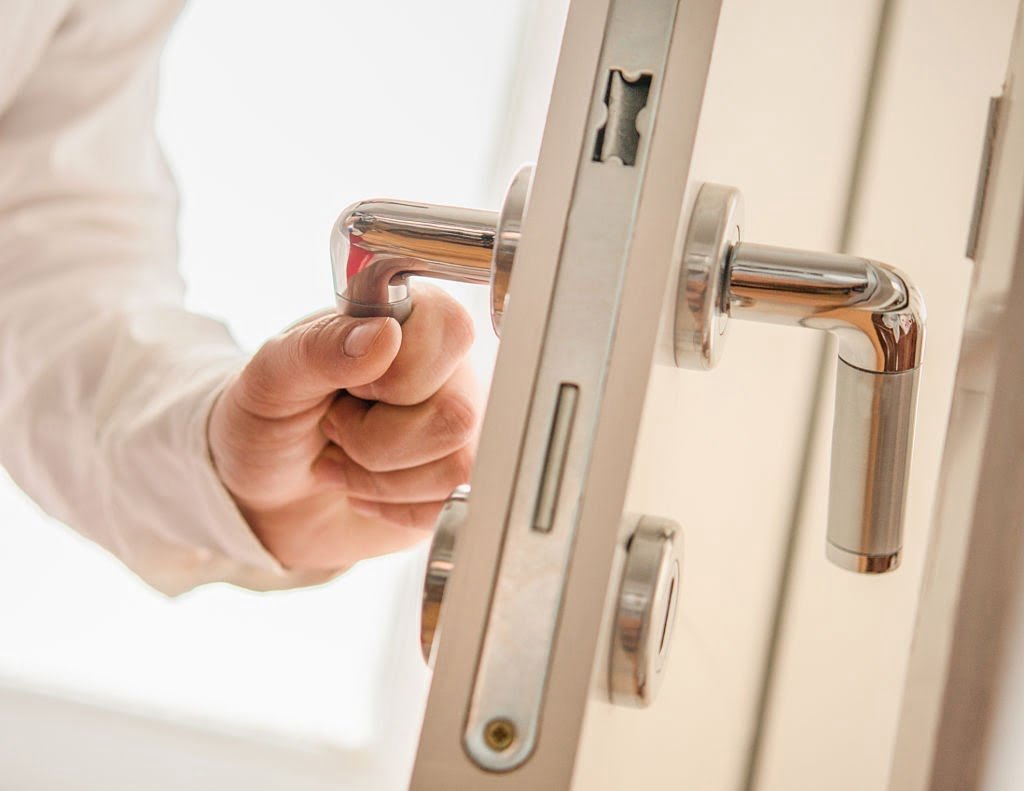
How much does it cost to replace door handles?
Replacing door handles in Australia typically costs between $8 and $229, with labour charges ranging from $30 to $175 per day, making the total cost dependent on the type and complexity of the handle and installation.
The Breakdown of Door Handle Costs
- Doorknobs – Prices start at $11, going up to $95.
- Door Handles – Ranging from as low as $8 to as high as $229.
Different Types of Door Handles
- Mortice Knobs – This costs anywhere between $41 and $245.
- Door Handles on a Rose – Prices range from $54 to $179.
- Door Handles on a Backplate – Costs vary from $45 to $590.
Australian design expert and creator Samantha Lockwood states, “When determining the cost of replacing door handles, it’s essential to consider factors such as the type of internal door and its installation complexity.
Internal Door Costs
The price of internal doors varies greatly, from $50 to several thousand dollars, based on size, configuration, material, and fitting and finishing costs.
Installation Complexity
Bi-fold, sliding, and stacking doors will generally have higher installation costs compared to standard single-hinged doors.
Lock Replacement Costs
Aside from door handle costs, lock replacement is another factor that can influence the total expense. Rekeying locks costs between $35 and $60, while lock drilling and new lock installation prices are available upon request. As for door repair services, the average price is around $50 per hour, with simpler jobs such as fixing hinges costing as low as $45 per hour and more complicated tasks like repairing lock mechanisms on multiple doors reaching up to $60 per hour.
By understanding these essential aspects and cost considerations, homeowners can make informed decisions when it comes to replacing door handles and locks, ensuring a perfect balance between security, aesthetics, and budget.
| Category | Cost Range |
|---|---|
| Door Handle Costs | |
| – Doorknobs | $11 – $95 |
| – Door Handles | $8 – $229 |
| – Mortice Knobs | $41 – $245 |
| – Door Handles on a Rose | $54 – $179 |
| – Door Handles on a Backplate | $45 – $590 |
| Labor Charges | $30 – $175 per day |
| Internal Door Costs | $50 – several thousand dollars |
| Installation Complexity | Varies based on door type |
| Lock Replacement Costs | |
| – Rekeying Locks | $35 – $60 |
| – Lock Drilling and Installation | Prices available upon request |
| Door Repair Services | |
| – Fixing Hinges | $45 per hour |
| – Repairing Lock Mechanisms | Up to $60 per hour |
How do you measure a French door handle?
Measuring a French door handle involves determining two critical dimensions: the distance between the centre of the handle and the lock and the spacing between the two screws securing the handle. It’s vital to ensure compatibility with your new handle, and getting these measurements can be done using a tape measure or ruler.
Key Measurements:
- Handle to Lock Distance: Measure the distance from the centre of the handle to the centre of the lock. This measurement is essential for a proper fit and smooth operation.
- Screw Spacing: Also, measure the distance between the two screws holding the handle. This will give you a clear indication of the appropriate replacement hardware.
Besides these two measurements, it’s crucial to determine the door’s backset. The backset refers to the distance between the edge of the door and the lock or latch’s centre. This helps in ensuring that your new hardware fits seamlessly when replacing an existing lock or latch.
Moreover, measuring the handle’s height is essential to ensure a comfortable usage level. You can use the small notch on the lock’s faceplate as a reference point for this measurement.
With all the necessary measurements gathered, you can proceed to remove the old handle by unscrewing both screws on the inside handle. Then, install the new handle by sliding the spindle into the spindle hole and positioning the handle into the door. Lastly, insert the two fixings into the inside door handle and tighten them securely.
By accurately measuring your French door handle and following these steps, you’ll achieve seamless hardware replacement, ensuring a perfect fit and enhancing your French door’s functionality and appearance.
How do I choose a replacement door handle?
To choose the perfect replacement door handle, you must first determine your door’s thickness, consider the handle style, weigh the pros and cons of knobs versus levers, and select the appropriate lock type. Whether you’re going for a contemporary, traditional, or a mix of both styles, these essential steps will guide you in picking the ideal door handle that aligns with your personal taste and complements your home’s architecture.
Door Thickness
The thickness of your door is a critical factor in selecting a suitable door handle; it varies among doors and influences the overall fitting of the handle. Ensure you measure your door’s thickness accurately to purchase a handle that will fit perfectly.
Handle Style & Type
Choosing the right handle style is essential in reflecting your personal taste and embracing the architectural style of your home. You may come across various types of entry door handles, including knobs, levers, and handle sets. It’s crucial to weigh the pros and cons of each type to make an informed decision that fits your lifestyle.
The door handles visible from the exterior should complement the style of your porch and open inward, thus harmonizing the foyer’s look. Ensure your chosen handle is aesthetically pleasing and pet-friendly to prevent unintended escapes.
Lock Type
Lock type is another vital consideration when selecting a door handle. Schlage door hardware, for instance, offers three primary options for interior door hardware: Bed & Bath, Hall & Closet, and Inactive. You can maintain a consistent look without compromising on style and finish while choosing your desired functions.
Moreover, don’t forget to consider your exterior doors, as upgrading your front door handle set or deadbolt may be timely while revamping your door hardware.
Additional Factors
While shopping for a door handle, a few more factors come into play to guarantee the ideal choice. These may include security, privacy, cost, locking mechanisms, measurements, ease of installation, and ease of use. Door knobs typically fall into two categories: those designed for interior doors and those made for exterior doors. With a plethora of options available, you’re bound to find the ideal door knob that caters to your needs without breaking the bank.
By following these critical steps and factoring in essential aspects, you’ll be well-equipped to choose a replacement door handle that enhances your home’s style, security, and convenience. And now, with the information you’ve gained, the perfect handle is within reach.
How do you replace a patio door lever?
A patio door lever can be replaced in a few easy steps, ensuring a seamless and convenient process for homeowners. The key to success lies in knowing how to safely remove the old handle, install a new one, and address any issues with the latch lever on the sliding glass door.
Remove the Old Handle Safely: Begin by carefully removing the two screws securing the door handle. Remember, avoid tampering with the screw on the thumb turn, as doing so might cause the lock reach-out to fall inside the door. With the screws out, turn the handle 90° clockwise, lift it up, and rotate it back to smoothly detach it from the door.
Please choose a Suitable New Handle: Before installing the new handle, take a moment to examine its compatibility with the old handle. Pay close attention to the width between the screws and the style of the handle. Ensuring a seamless fit will help streamline the installation process.
Install the New Handle: To fit the new handle, reverse the steps taken to remove the initial lever. Insert the two screws through the handle and into the backing plate, securing it firmly in place.
Replace the Latch Lever (If Necessary): If the latch lever on your sliding glass door also requires replacement, rest assured that the process closely mirrors that of replacing the handle.
Equipped with this knowledge, replacing a patio door lever becomes a breeze, guaranteeing a swift and hassle-free experience for any homeowner looking to enhance the functionality of their living space.
Wrapping Up Your French Door Handle Replacement Journey
Replacing French door handles is a feasible and often straightforward task that can breathe new life into your doors. By understanding the various types of handles, their functionality, and the cost associated with replacement, you can confidently embark on your French door handle replacement journey.
Remember to measure your existing handles, choose the right replacement, and follow the proper installation steps for a seamless transition.
With this knowledge at your fingertips, you can now make informed decisions about your French door hardware, ultimately enhancing your home’s overall aesthetic and functionality.
Related Articles:
Charm and Elegance Unleashed: The Timeless Appeal of Timber French Doors
Timber French doors are a timeless architectural element that grace homes with elegance, natural warmth, and beauty. With their characteristic large glass panels surrounded by wide stiles and rails made of solid wood, these doors create an inviting transition between...
French Doors Buying Guide: An In-Depth Look
French doors are a popular choice for homeowners looking to enhance natural light, ventilation, and aesthetic appeal. With their characteristic large glass panes and narrow dividing frames, these elegant doors create an inviting indoor-outdoor flow. This comprehensive...
Standard French Door Glass Size: A Complete Guide
French doors are an elegant and timeless architectural feature known for their decorative glass panes that allow ample natural light into a space. But what are the standard glass sizes for these iconic doors? Understanding the typical dimensions of French door glass...
How Big Can French Doors Be in CM? A Complete Guide
French doors are a classic and elegant addition to any home. With their large glass panes and delicate dividers, they allow ample natural light into a space while providing a beautiful architectural focal point. But before installing these iconic doors, it's important...
Mastering French Door Dimensions: Your Ultimate Guide to Exterior Sizes
French doors are a classic and timeless architectural feature that can add elegance, charm and functionality to a home. As their name suggests, they originated in France but have been popular in the US and elsewhere for over a century. I'm a homeowner looking to...
What Are Active or Stationary French Doors
Welcome to our guide on active and stationary French doors! Picture this: you're standing in your home, longing for elegance and functionality. That's where French doors come in. These beauties consist of two door panels, one that swings open (the active side) and one...
How to Stop French Doors Slamming
French doors constantly slamming shut, causing frustration and potential damage? We've got you covered. With some maintenance and simple adjustments, you can prevent your doors from slamming and enjoy their beauty and functionality for years. Regular inspection and...
From Classic to Contemporary: The Impact of French Doors on Modern Architectural
Discover the impact of French doors on modern architectural design. From classic elegance to seamless indoor-outdoor flow, unlock the beauty of contemporary living.
The Architectural Impact of French Doors: A Historical Perspective
Discover the architectural influence of French doors! From Europe to America, their impact on design is unparalleled.
French Door Sizes: A Complete Guide to Standard and Custom Dimensions
As I step through the threshold of knowledge, let me guide you through the world of French door sizes. This comprehensive article explores the standard dimensions for exterior and interior French doors and the exciting possibilities of custom sizes. I'll also reveal...



